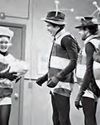Walkable downtowns will save the American city! Except that most of them aren’t really, and won’t.

ON A SPRING EVENING in Nashville, I join the line outside the Station Inn, the venerable joint where grizzled fiddlers and young banjo hotshots converge for the Sunday-night bluegrass jam. A decade ago, the squat stone structure was the only sign of life in an industrial tract down by the rail yards. The beer is still cheap and the music homespun, but outside the metal door is the Gulch, “a hotspot for young urbanites,” as the city’s visitor website puts it. There’s an Urban Outfitters across the street, next to a Lucchese store selling $500 cowboy boots. Down the block, a cluster of high-rise rental buildings sprouts from the vale of parking lots and one-story warehouses. This is what the 21st-century American city is supposed to be, a satisfying and active mix of cultural holdovers, storefronts, and apartment buildings. Except the sidewalks are empty and the streets as wide as rivers. In reality, it’s a lukewarm spot at best.
America is getting cities wrong again. For decades, planners, mayors, and activists have promoted the dense, walkable downtown as the solution to a vast array of problems. Studies and news articles have celebrated the young people who flock to urban centers, live in apartments, walk to school, and bike to work, promoting diversity and tolerance, raising property values and coffee standards, and foretelling an end to sprawl. But as soon as you try walking around Nashville or Phoenix or Louisville, that optimism evaporates. A theoretically walkable neighborhood is often just a tourist strip, or a tiny nugget that you cross in a few minutes on foot, before hitting a multilane road or a strip mall. A shopping district consists of a coffee place, a restaurant, and a boutique or two.
Denne historien er fra June 11, 2018-utgaven av New York magazine.
Start din 7-dagers gratis prøveperiode på Magzter GOLD for å få tilgang til tusenvis av utvalgte premiumhistorier og 9000+ magasiner og aviser.
Allerede abonnent ? Logg på
Denne historien er fra June 11, 2018-utgaven av New York magazine.
Start din 7-dagers gratis prøveperiode på Magzter GOLD for å få tilgang til tusenvis av utvalgte premiumhistorier og 9000+ magasiner og aviser.
Allerede abonnent? Logg på

Enchanting and Exhausting
Wicked makes a charming but bloated film.

Nicole Kidman Lets Loose
She's having a grand old time playing wealthy matriarchs on the verge of blowing their lives up.

How Mike Myers Makes His Own Reality
Directing him in Austin Powers taught me what it means to be really, truly funny.

The Art of Surrender
Four decades into his career, Willem Dafoe is more curious about his craft than ever.

The Big Macher Restaurant Is Back
ON A WARM NIGHT in October, a red carpet ran down a length of East 26th Street.

Showing Its Age
Borgo displays a confidence that can he only from experience.

Keeping It Simple on Lower Fifth
Jack Ceglic and Manuel Fernandez-Casteleiro's apartment is full of stories but not distractions.

REASON TO LOVE NEW YORK
THERE'S NOT MUCH in New York that has staying power. Every other day, a new scandal outscandals whatever we were just scandalized by; every few years, a hotter, scarier downtown set emerges; the yoga studio up the block from your apartment that used to be a coffee shop has now become a hybrid drug front and yarn store.

Disunion: Ingrid Rojas Contreras
A Rift in the Family My in-laws gave me a book by a eugenicist. Our relationship is over.

Gwen Whiting
Two years after a mass recall and a bacterial outbreak, the founder of the Laundress is on cleanup duty.